MGT2070 - HRM Challenges in Multinational Companies: Detailed Report
VerifiedAdded on 2023/01/16
|9
|2187
|87
Report
AI Summary
This report identifies and analyzes various challenges faced by Human Resource Management (HRM) in multinational companies (MNCs). It covers key areas such as HR planning, recruitment and selection, employee retention, leadership development, career development, and compensation and benefits. The report highlights specific issues like adapting to innovation, environmental concerns, attracting and retaining talent, developing the right leadership mindset, and managing global compensation policies. Recommendations are provided to address these challenges, including implementing fixed policies, utilizing Maslow's hierarchy of needs for employee motivation, developing appropriate performance management systems, and fostering transparency within the organization. The report concludes that by addressing these challenges through strategic tools and approaches, MNCs can effectively manage their human resources on a global scale.
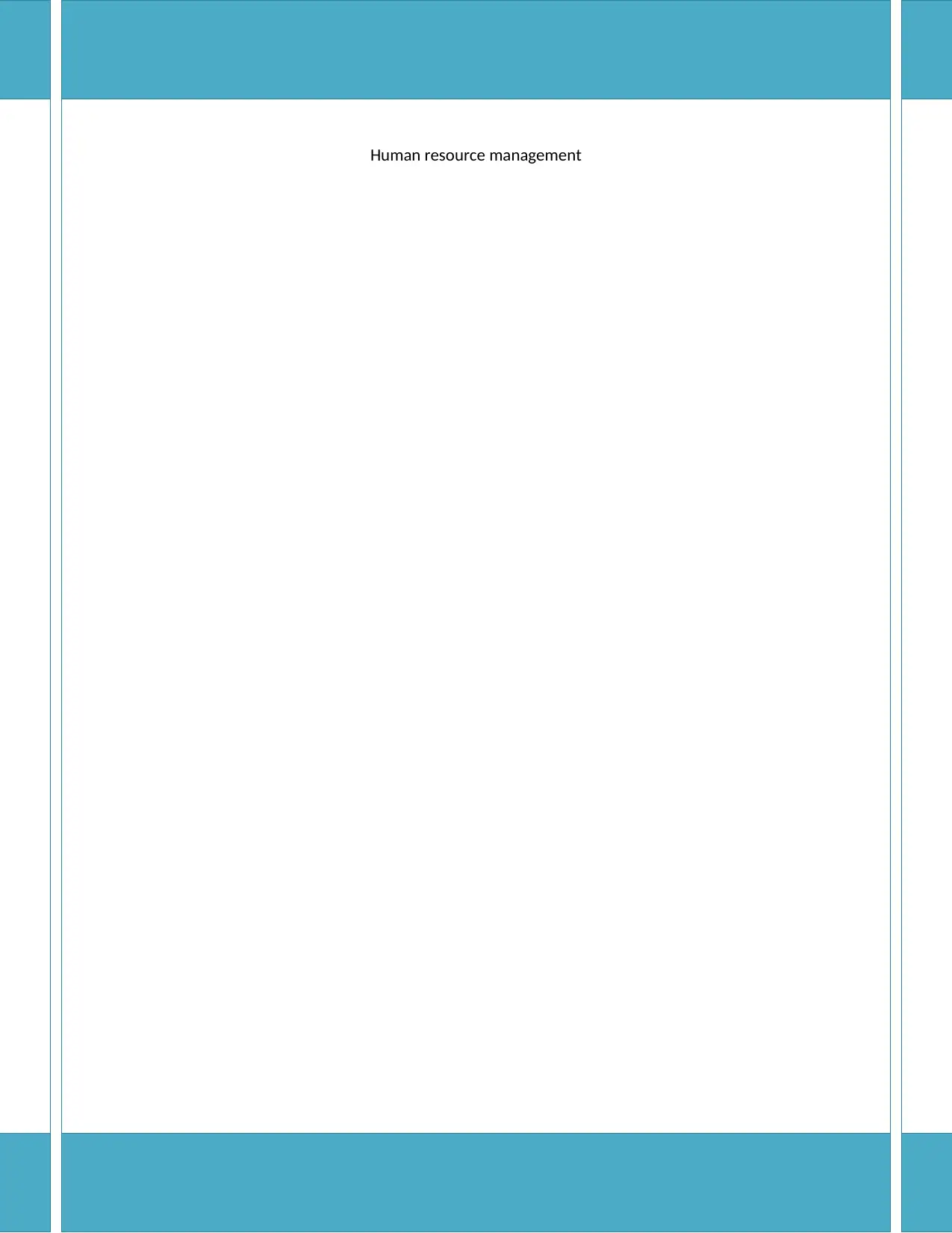
Human resource management
Paraphrase This Document
Need a fresh take? Get an instant paraphrase of this document with our AI Paraphraser
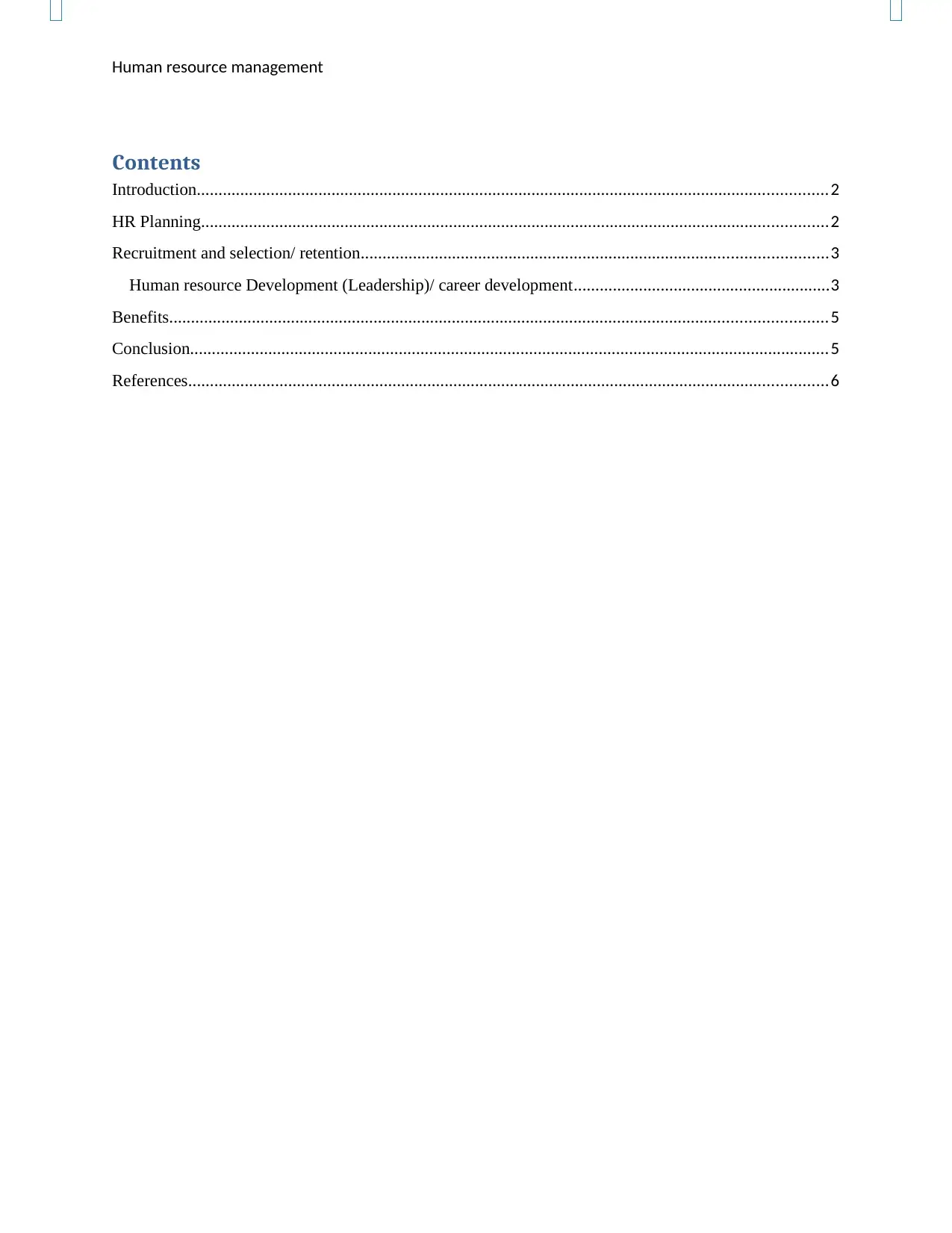
Human resource management
Contents
Introduction.................................................................................................................................................2
HR Planning................................................................................................................................................2
Recruitment and selection/ retention...........................................................................................................3
Human resource Development (Leadership)/ career development...........................................................3
Benefits.......................................................................................................................................................5
Conclusion...................................................................................................................................................5
References...................................................................................................................................................6
Contents
Introduction.................................................................................................................................................2
HR Planning................................................................................................................................................2
Recruitment and selection/ retention...........................................................................................................3
Human resource Development (Leadership)/ career development...........................................................3
Benefits.......................................................................................................................................................5
Conclusion...................................................................................................................................................5
References...................................................................................................................................................6
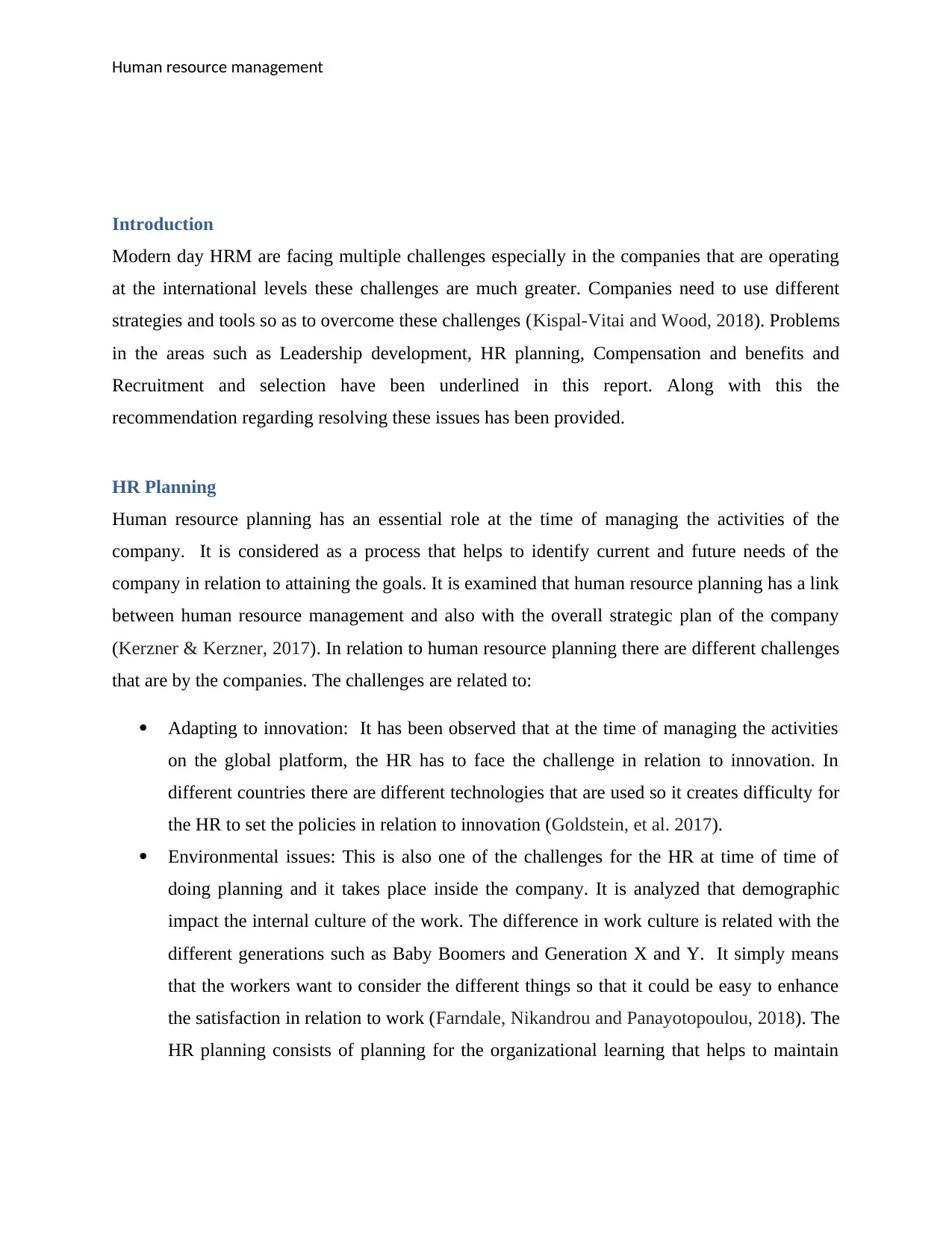
Human resource management
Introduction
Modern day HRM are facing multiple challenges especially in the companies that are operating
at the international levels these challenges are much greater. Companies need to use different
strategies and tools so as to overcome these challenges (Kispal-Vitai and Wood, 2018). Problems
in the areas such as Leadership development, HR planning, Compensation and benefits and
Recruitment and selection have been underlined in this report. Along with this the
recommendation regarding resolving these issues has been provided.
HR Planning
Human resource planning has an essential role at the time of managing the activities of the
company. It is considered as a process that helps to identify current and future needs of the
company in relation to attaining the goals. It is examined that human resource planning has a link
between human resource management and also with the overall strategic plan of the company
(Kerzner & Kerzner, 2017). In relation to human resource planning there are different challenges
that are by the companies. The challenges are related to:
Adapting to innovation: It has been observed that at the time of managing the activities
on the global platform, the HR has to face the challenge in relation to innovation. In
different countries there are different technologies that are used so it creates difficulty for
the HR to set the policies in relation to innovation (Goldstein, et al. 2017).
Environmental issues: This is also one of the challenges for the HR at time of time of
doing planning and it takes place inside the company. It is analyzed that demographic
impact the internal culture of the work. The difference in work culture is related with the
different generations such as Baby Boomers and Generation X and Y. It simply means
that the workers want to consider the different things so that it could be easy to enhance
the satisfaction in relation to work (Farndale, Nikandrou and Panayotopoulou, 2018). The
HR planning consists of planning for the organizational learning that helps to maintain
Introduction
Modern day HRM are facing multiple challenges especially in the companies that are operating
at the international levels these challenges are much greater. Companies need to use different
strategies and tools so as to overcome these challenges (Kispal-Vitai and Wood, 2018). Problems
in the areas such as Leadership development, HR planning, Compensation and benefits and
Recruitment and selection have been underlined in this report. Along with this the
recommendation regarding resolving these issues has been provided.
HR Planning
Human resource planning has an essential role at the time of managing the activities of the
company. It is considered as a process that helps to identify current and future needs of the
company in relation to attaining the goals. It is examined that human resource planning has a link
between human resource management and also with the overall strategic plan of the company
(Kerzner & Kerzner, 2017). In relation to human resource planning there are different challenges
that are by the companies. The challenges are related to:
Adapting to innovation: It has been observed that at the time of managing the activities
on the global platform, the HR has to face the challenge in relation to innovation. In
different countries there are different technologies that are used so it creates difficulty for
the HR to set the policies in relation to innovation (Goldstein, et al. 2017).
Environmental issues: This is also one of the challenges for the HR at time of time of
doing planning and it takes place inside the company. It is analyzed that demographic
impact the internal culture of the work. The difference in work culture is related with the
different generations such as Baby Boomers and Generation X and Y. It simply means
that the workers want to consider the different things so that it could be easy to enhance
the satisfaction in relation to work (Farndale, Nikandrou and Panayotopoulou, 2018). The
HR planning consists of planning for the organizational learning that helps to maintain
⊘ This is a preview!⊘
Do you want full access?
Subscribe today to unlock all pages.

Trusted by 1+ million students worldwide
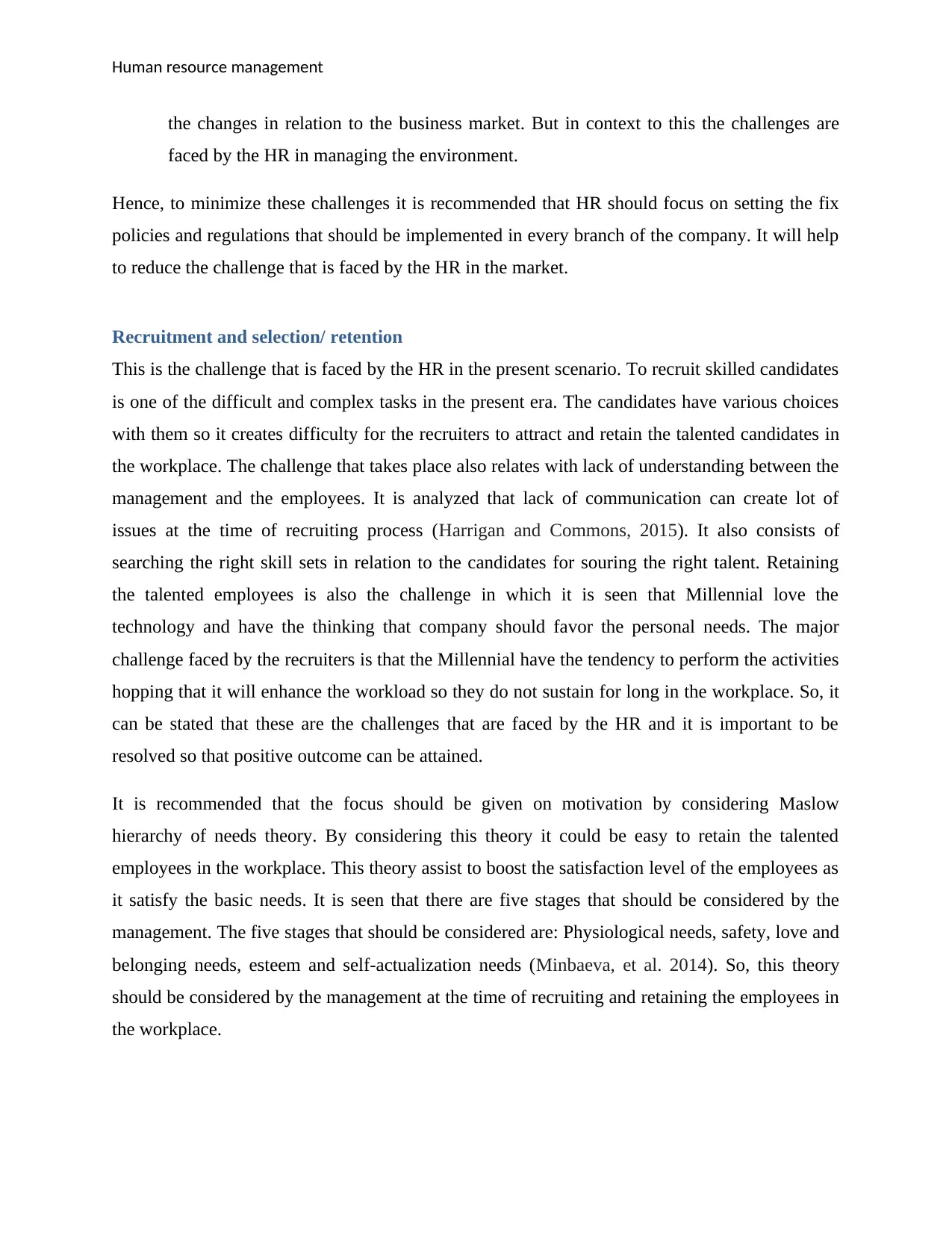
Human resource management
the changes in relation to the business market. But in context to this the challenges are
faced by the HR in managing the environment.
Hence, to minimize these challenges it is recommended that HR should focus on setting the fix
policies and regulations that should be implemented in every branch of the company. It will help
to reduce the challenge that is faced by the HR in the market.
Recruitment and selection/ retention
This is the challenge that is faced by the HR in the present scenario. To recruit skilled candidates
is one of the difficult and complex tasks in the present era. The candidates have various choices
with them so it creates difficulty for the recruiters to attract and retain the talented candidates in
the workplace. The challenge that takes place also relates with lack of understanding between the
management and the employees. It is analyzed that lack of communication can create lot of
issues at the time of recruiting process (Harrigan and Commons, 2015). It also consists of
searching the right skill sets in relation to the candidates for souring the right talent. Retaining
the talented employees is also the challenge in which it is seen that Millennial love the
technology and have the thinking that company should favor the personal needs. The major
challenge faced by the recruiters is that the Millennial have the tendency to perform the activities
hopping that it will enhance the workload so they do not sustain for long in the workplace. So, it
can be stated that these are the challenges that are faced by the HR and it is important to be
resolved so that positive outcome can be attained.
It is recommended that the focus should be given on motivation by considering Maslow
hierarchy of needs theory. By considering this theory it could be easy to retain the talented
employees in the workplace. This theory assist to boost the satisfaction level of the employees as
it satisfy the basic needs. It is seen that there are five stages that should be considered by the
management. The five stages that should be considered are: Physiological needs, safety, love and
belonging needs, esteem and self-actualization needs (Minbaeva, et al. 2014). So, this theory
should be considered by the management at the time of recruiting and retaining the employees in
the workplace.
the changes in relation to the business market. But in context to this the challenges are
faced by the HR in managing the environment.
Hence, to minimize these challenges it is recommended that HR should focus on setting the fix
policies and regulations that should be implemented in every branch of the company. It will help
to reduce the challenge that is faced by the HR in the market.
Recruitment and selection/ retention
This is the challenge that is faced by the HR in the present scenario. To recruit skilled candidates
is one of the difficult and complex tasks in the present era. The candidates have various choices
with them so it creates difficulty for the recruiters to attract and retain the talented candidates in
the workplace. The challenge that takes place also relates with lack of understanding between the
management and the employees. It is analyzed that lack of communication can create lot of
issues at the time of recruiting process (Harrigan and Commons, 2015). It also consists of
searching the right skill sets in relation to the candidates for souring the right talent. Retaining
the talented employees is also the challenge in which it is seen that Millennial love the
technology and have the thinking that company should favor the personal needs. The major
challenge faced by the recruiters is that the Millennial have the tendency to perform the activities
hopping that it will enhance the workload so they do not sustain for long in the workplace. So, it
can be stated that these are the challenges that are faced by the HR and it is important to be
resolved so that positive outcome can be attained.
It is recommended that the focus should be given on motivation by considering Maslow
hierarchy of needs theory. By considering this theory it could be easy to retain the talented
employees in the workplace. This theory assist to boost the satisfaction level of the employees as
it satisfy the basic needs. It is seen that there are five stages that should be considered by the
management. The five stages that should be considered are: Physiological needs, safety, love and
belonging needs, esteem and self-actualization needs (Minbaeva, et al. 2014). So, this theory
should be considered by the management at the time of recruiting and retaining the employees in
the workplace.
Paraphrase This Document
Need a fresh take? Get an instant paraphrase of this document with our AI Paraphraser
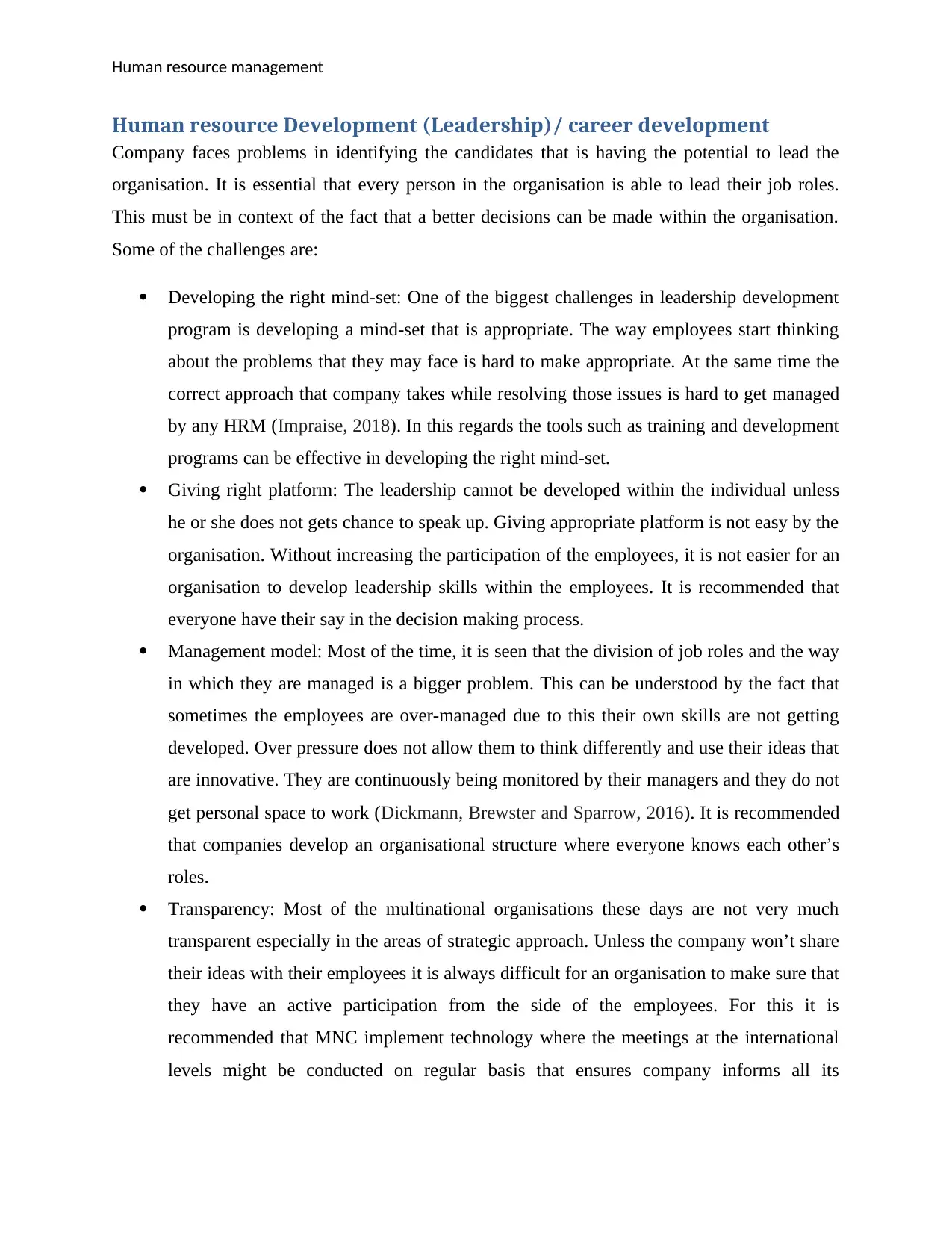
Human resource management
Human resource Development (Leadership)/ career development
Company faces problems in identifying the candidates that is having the potential to lead the
organisation. It is essential that every person in the organisation is able to lead their job roles.
This must be in context of the fact that a better decisions can be made within the organisation.
Some of the challenges are:
Developing the right mind-set: One of the biggest challenges in leadership development
program is developing a mind-set that is appropriate. The way employees start thinking
about the problems that they may face is hard to make appropriate. At the same time the
correct approach that company takes while resolving those issues is hard to get managed
by any HRM (Impraise, 2018). In this regards the tools such as training and development
programs can be effective in developing the right mind-set.
Giving right platform: The leadership cannot be developed within the individual unless
he or she does not gets chance to speak up. Giving appropriate platform is not easy by the
organisation. Without increasing the participation of the employees, it is not easier for an
organisation to develop leadership skills within the employees. It is recommended that
everyone have their say in the decision making process.
Management model: Most of the time, it is seen that the division of job roles and the way
in which they are managed is a bigger problem. This can be understood by the fact that
sometimes the employees are over-managed due to this their own skills are not getting
developed. Over pressure does not allow them to think differently and use their ideas that
are innovative. They are continuously being monitored by their managers and they do not
get personal space to work (Dickmann, Brewster and Sparrow, 2016). It is recommended
that companies develop an organisational structure where everyone knows each other’s
roles.
Transparency: Most of the multinational organisations these days are not very much
transparent especially in the areas of strategic approach. Unless the company won’t share
their ideas with their employees it is always difficult for an organisation to make sure that
they have an active participation from the side of the employees. For this it is
recommended that MNC implement technology where the meetings at the international
levels might be conducted on regular basis that ensures company informs all its
Human resource Development (Leadership)/ career development
Company faces problems in identifying the candidates that is having the potential to lead the
organisation. It is essential that every person in the organisation is able to lead their job roles.
This must be in context of the fact that a better decisions can be made within the organisation.
Some of the challenges are:
Developing the right mind-set: One of the biggest challenges in leadership development
program is developing a mind-set that is appropriate. The way employees start thinking
about the problems that they may face is hard to make appropriate. At the same time the
correct approach that company takes while resolving those issues is hard to get managed
by any HRM (Impraise, 2018). In this regards the tools such as training and development
programs can be effective in developing the right mind-set.
Giving right platform: The leadership cannot be developed within the individual unless
he or she does not gets chance to speak up. Giving appropriate platform is not easy by the
organisation. Without increasing the participation of the employees, it is not easier for an
organisation to develop leadership skills within the employees. It is recommended that
everyone have their say in the decision making process.
Management model: Most of the time, it is seen that the division of job roles and the way
in which they are managed is a bigger problem. This can be understood by the fact that
sometimes the employees are over-managed due to this their own skills are not getting
developed. Over pressure does not allow them to think differently and use their ideas that
are innovative. They are continuously being monitored by their managers and they do not
get personal space to work (Dickmann, Brewster and Sparrow, 2016). It is recommended
that companies develop an organisational structure where everyone knows each other’s
roles.
Transparency: Most of the multinational organisations these days are not very much
transparent especially in the areas of strategic approach. Unless the company won’t share
their ideas with their employees it is always difficult for an organisation to make sure that
they have an active participation from the side of the employees. For this it is
recommended that MNC implement technology where the meetings at the international
levels might be conducted on regular basis that ensures company informs all its
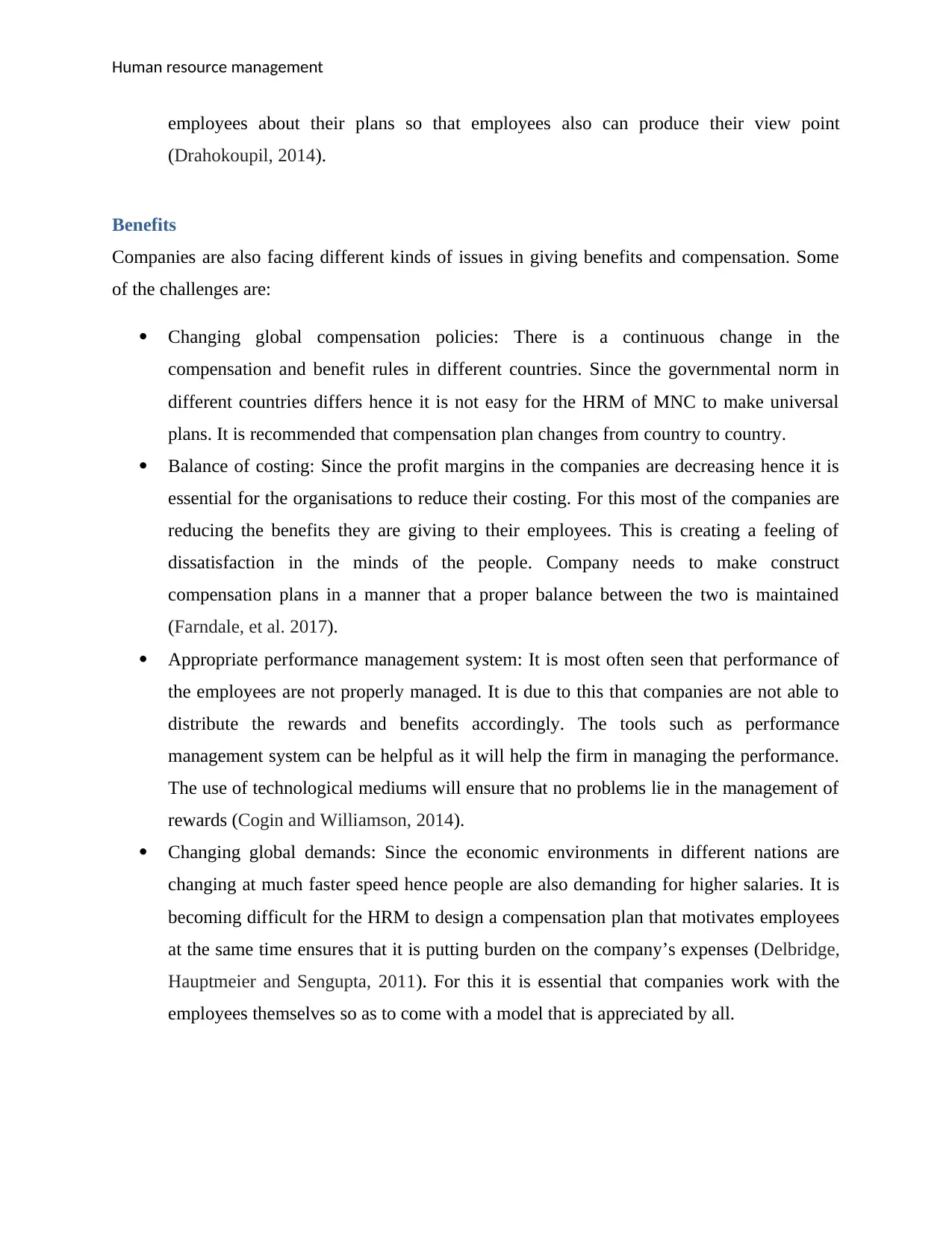
Human resource management
employees about their plans so that employees also can produce their view point
(Drahokoupil, 2014).
Benefits
Companies are also facing different kinds of issues in giving benefits and compensation. Some
of the challenges are:
Changing global compensation policies: There is a continuous change in the
compensation and benefit rules in different countries. Since the governmental norm in
different countries differs hence it is not easy for the HRM of MNC to make universal
plans. It is recommended that compensation plan changes from country to country.
Balance of costing: Since the profit margins in the companies are decreasing hence it is
essential for the organisations to reduce their costing. For this most of the companies are
reducing the benefits they are giving to their employees. This is creating a feeling of
dissatisfaction in the minds of the people. Company needs to make construct
compensation plans in a manner that a proper balance between the two is maintained
(Farndale, et al. 2017).
Appropriate performance management system: It is most often seen that performance of
the employees are not properly managed. It is due to this that companies are not able to
distribute the rewards and benefits accordingly. The tools such as performance
management system can be helpful as it will help the firm in managing the performance.
The use of technological mediums will ensure that no problems lie in the management of
rewards (Cogin and Williamson, 2014).
Changing global demands: Since the economic environments in different nations are
changing at much faster speed hence people are also demanding for higher salaries. It is
becoming difficult for the HRM to design a compensation plan that motivates employees
at the same time ensures that it is putting burden on the company’s expenses (Delbridge,
Hauptmeier and Sengupta, 2011). For this it is essential that companies work with the
employees themselves so as to come with a model that is appreciated by all.
employees about their plans so that employees also can produce their view point
(Drahokoupil, 2014).
Benefits
Companies are also facing different kinds of issues in giving benefits and compensation. Some
of the challenges are:
Changing global compensation policies: There is a continuous change in the
compensation and benefit rules in different countries. Since the governmental norm in
different countries differs hence it is not easy for the HRM of MNC to make universal
plans. It is recommended that compensation plan changes from country to country.
Balance of costing: Since the profit margins in the companies are decreasing hence it is
essential for the organisations to reduce their costing. For this most of the companies are
reducing the benefits they are giving to their employees. This is creating a feeling of
dissatisfaction in the minds of the people. Company needs to make construct
compensation plans in a manner that a proper balance between the two is maintained
(Farndale, et al. 2017).
Appropriate performance management system: It is most often seen that performance of
the employees are not properly managed. It is due to this that companies are not able to
distribute the rewards and benefits accordingly. The tools such as performance
management system can be helpful as it will help the firm in managing the performance.
The use of technological mediums will ensure that no problems lie in the management of
rewards (Cogin and Williamson, 2014).
Changing global demands: Since the economic environments in different nations are
changing at much faster speed hence people are also demanding for higher salaries. It is
becoming difficult for the HRM to design a compensation plan that motivates employees
at the same time ensures that it is putting burden on the company’s expenses (Delbridge,
Hauptmeier and Sengupta, 2011). For this it is essential that companies work with the
employees themselves so as to come with a model that is appreciated by all.
⊘ This is a preview!⊘
Do you want full access?
Subscribe today to unlock all pages.

Trusted by 1+ million students worldwide
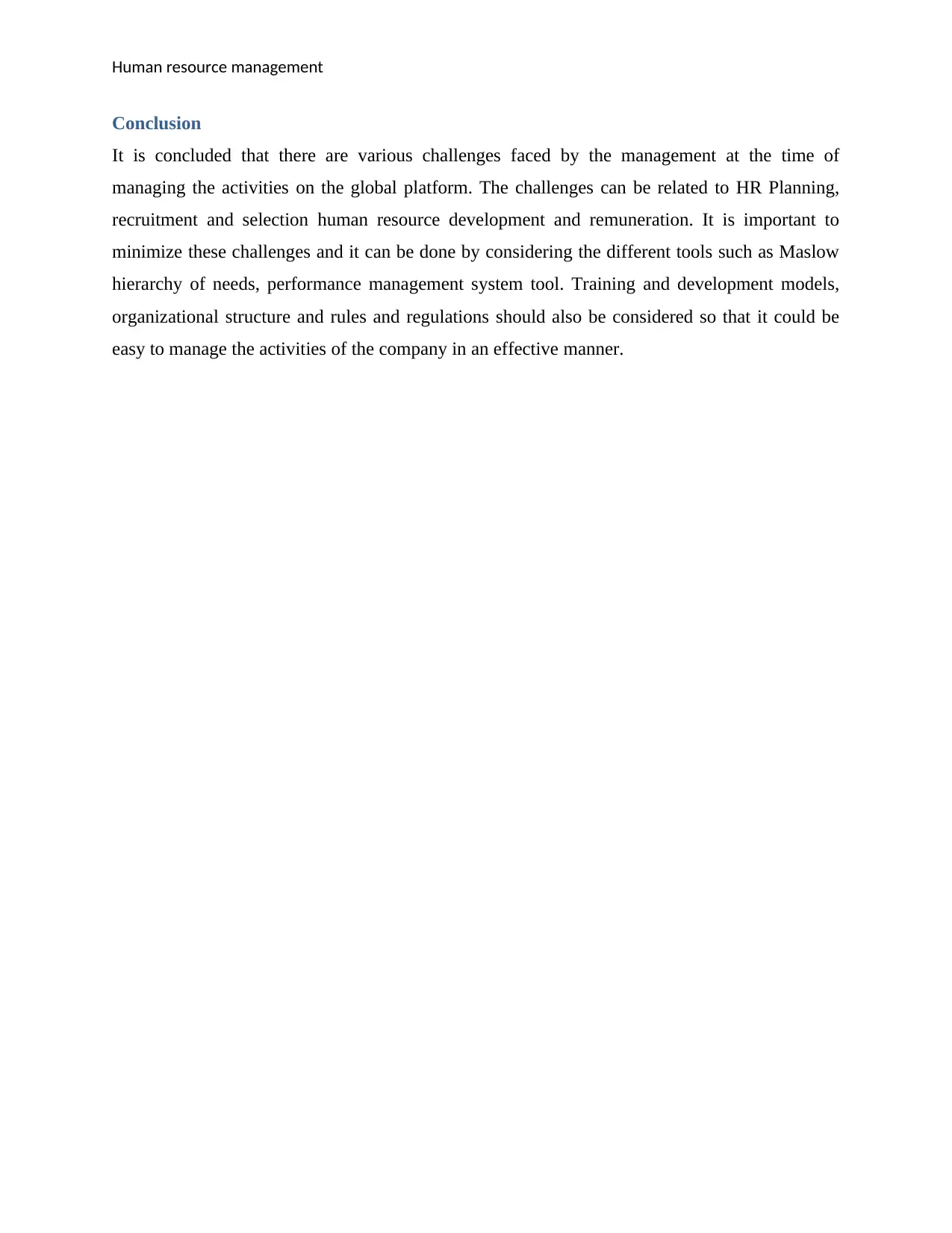
Human resource management
Conclusion
It is concluded that there are various challenges faced by the management at the time of
managing the activities on the global platform. The challenges can be related to HR Planning,
recruitment and selection human resource development and remuneration. It is important to
minimize these challenges and it can be done by considering the different tools such as Maslow
hierarchy of needs, performance management system tool. Training and development models,
organizational structure and rules and regulations should also be considered so that it could be
easy to manage the activities of the company in an effective manner.
Conclusion
It is concluded that there are various challenges faced by the management at the time of
managing the activities on the global platform. The challenges can be related to HR Planning,
recruitment and selection human resource development and remuneration. It is important to
minimize these challenges and it can be done by considering the different tools such as Maslow
hierarchy of needs, performance management system tool. Training and development models,
organizational structure and rules and regulations should also be considered so that it could be
easy to manage the activities of the company in an effective manner.
Paraphrase This Document
Need a fresh take? Get an instant paraphrase of this document with our AI Paraphraser
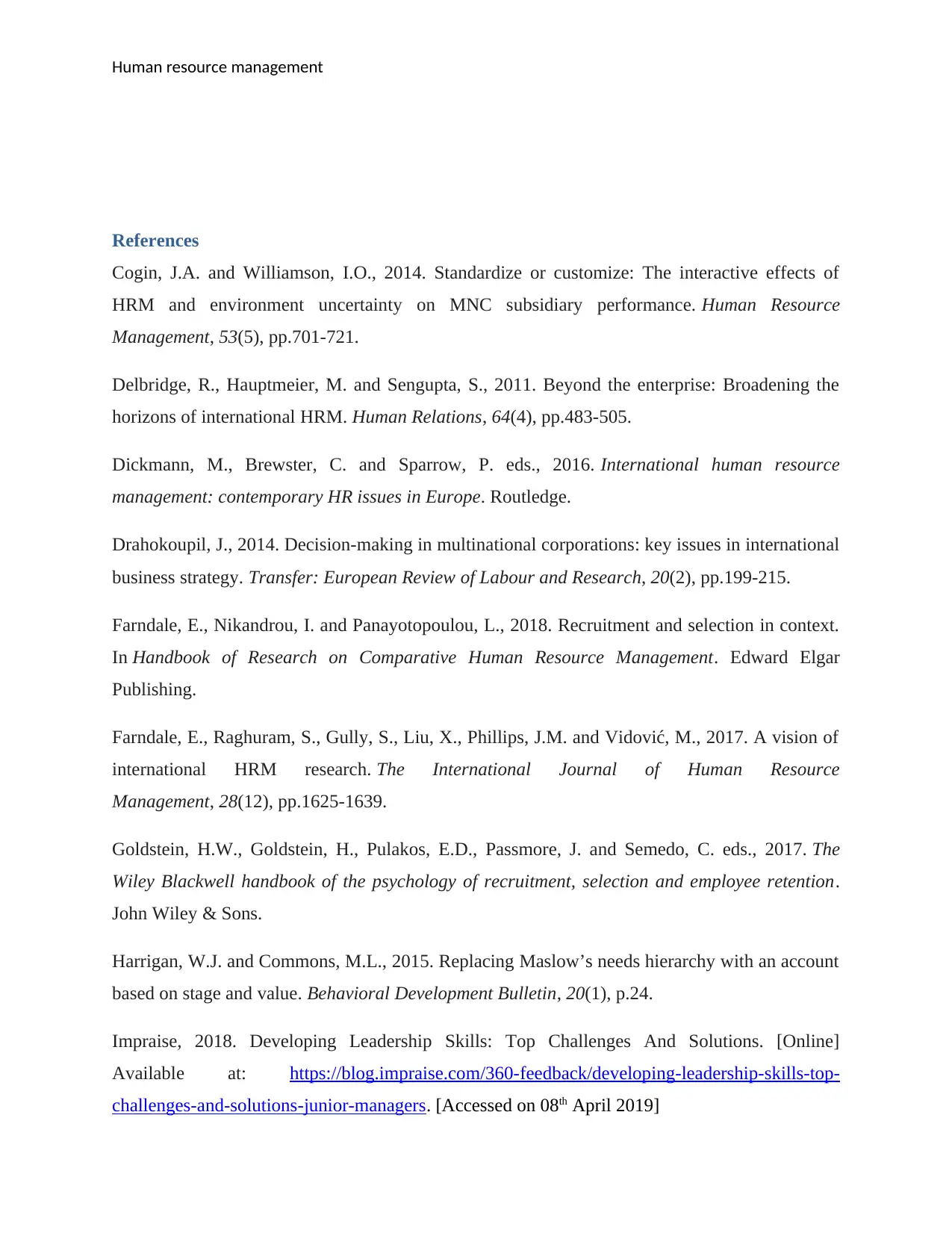
Human resource management
References
Cogin, J.A. and Williamson, I.O., 2014. Standardize or customize: The interactive effects of
HRM and environment uncertainty on MNC subsidiary performance. Human Resource
Management, 53(5), pp.701-721.
Delbridge, R., Hauptmeier, M. and Sengupta, S., 2011. Beyond the enterprise: Broadening the
horizons of international HRM. Human Relations, 64(4), pp.483-505.
Dickmann, M., Brewster, C. and Sparrow, P. eds., 2016. International human resource
management: contemporary HR issues in Europe. Routledge.
Drahokoupil, J., 2014. Decision-making in multinational corporations: key issues in international
business strategy. Transfer: European Review of Labour and Research, 20(2), pp.199-215.
Farndale, E., Nikandrou, I. and Panayotopoulou, L., 2018. Recruitment and selection in context.
In Handbook of Research on Comparative Human Resource Management. Edward Elgar
Publishing.
Farndale, E., Raghuram, S., Gully, S., Liu, X., Phillips, J.M. and Vidović, M., 2017. A vision of
international HRM research. The International Journal of Human Resource
Management, 28(12), pp.1625-1639.
Goldstein, H.W., Goldstein, H., Pulakos, E.D., Passmore, J. and Semedo, C. eds., 2017. The
Wiley Blackwell handbook of the psychology of recruitment, selection and employee retention.
John Wiley & Sons.
Harrigan, W.J. and Commons, M.L., 2015. Replacing Maslow’s needs hierarchy with an account
based on stage and value. Behavioral Development Bulletin, 20(1), p.24.
Impraise, 2018. Developing Leadership Skills: Top Challenges And Solutions. [Online]
Available at: https://blog.impraise.com/360-feedback/developing-leadership-skills-top-
challenges-and-solutions-junior-managers. [Accessed on 08th April 2019]
References
Cogin, J.A. and Williamson, I.O., 2014. Standardize or customize: The interactive effects of
HRM and environment uncertainty on MNC subsidiary performance. Human Resource
Management, 53(5), pp.701-721.
Delbridge, R., Hauptmeier, M. and Sengupta, S., 2011. Beyond the enterprise: Broadening the
horizons of international HRM. Human Relations, 64(4), pp.483-505.
Dickmann, M., Brewster, C. and Sparrow, P. eds., 2016. International human resource
management: contemporary HR issues in Europe. Routledge.
Drahokoupil, J., 2014. Decision-making in multinational corporations: key issues in international
business strategy. Transfer: European Review of Labour and Research, 20(2), pp.199-215.
Farndale, E., Nikandrou, I. and Panayotopoulou, L., 2018. Recruitment and selection in context.
In Handbook of Research on Comparative Human Resource Management. Edward Elgar
Publishing.
Farndale, E., Raghuram, S., Gully, S., Liu, X., Phillips, J.M. and Vidović, M., 2017. A vision of
international HRM research. The International Journal of Human Resource
Management, 28(12), pp.1625-1639.
Goldstein, H.W., Goldstein, H., Pulakos, E.D., Passmore, J. and Semedo, C. eds., 2017. The
Wiley Blackwell handbook of the psychology of recruitment, selection and employee retention.
John Wiley & Sons.
Harrigan, W.J. and Commons, M.L., 2015. Replacing Maslow’s needs hierarchy with an account
based on stage and value. Behavioral Development Bulletin, 20(1), p.24.
Impraise, 2018. Developing Leadership Skills: Top Challenges And Solutions. [Online]
Available at: https://blog.impraise.com/360-feedback/developing-leadership-skills-top-
challenges-and-solutions-junior-managers. [Accessed on 08th April 2019]
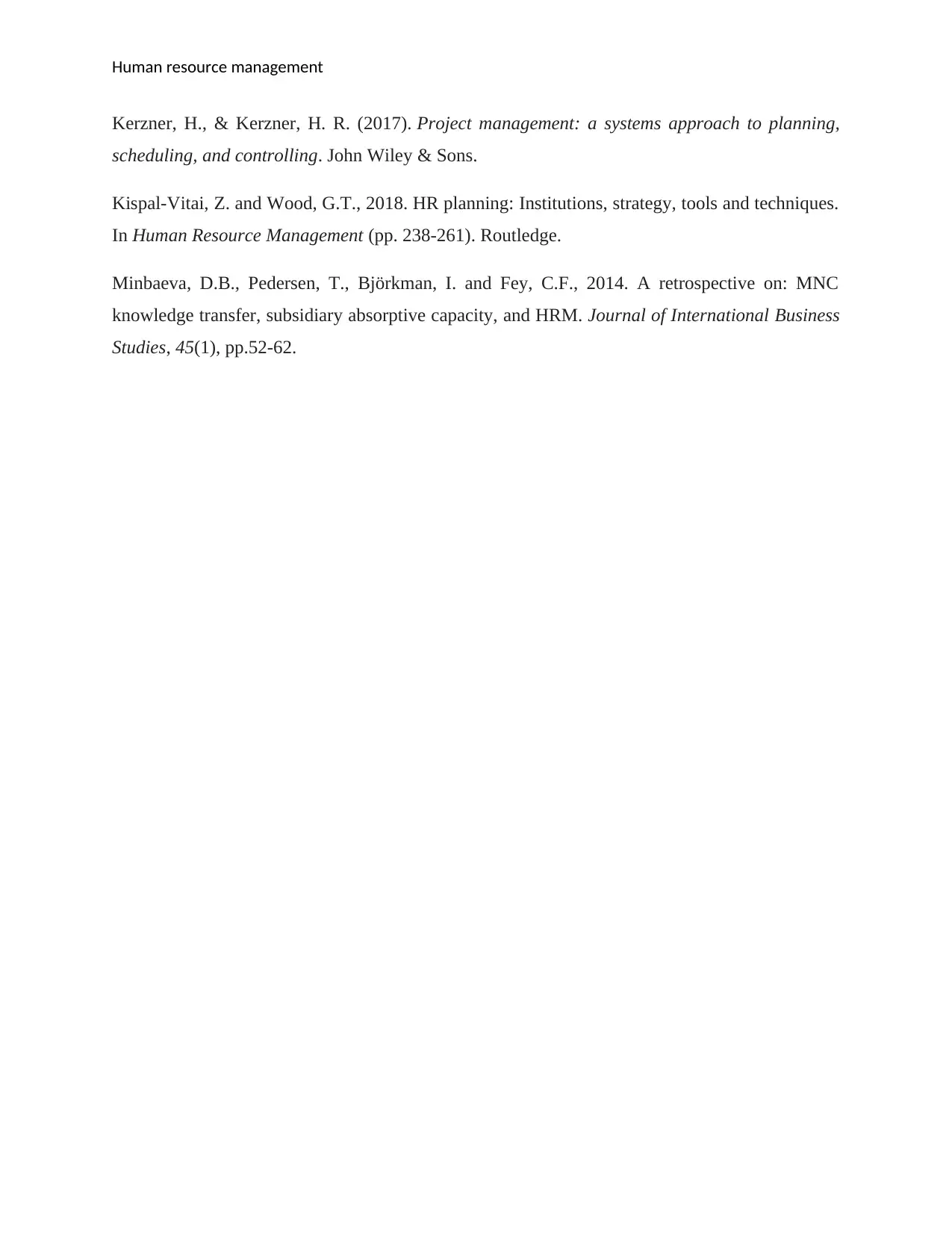
Human resource management
Kerzner, H., & Kerzner, H. R. (2017). Project management: a systems approach to planning,
scheduling, and controlling. John Wiley & Sons.
Kispal-Vitai, Z. and Wood, G.T., 2018. HR planning: Institutions, strategy, tools and techniques.
In Human Resource Management (pp. 238-261). Routledge.
Minbaeva, D.B., Pedersen, T., Björkman, I. and Fey, C.F., 2014. A retrospective on: MNC
knowledge transfer, subsidiary absorptive capacity, and HRM. Journal of International Business
Studies, 45(1), pp.52-62.
Kerzner, H., & Kerzner, H. R. (2017). Project management: a systems approach to planning,
scheduling, and controlling. John Wiley & Sons.
Kispal-Vitai, Z. and Wood, G.T., 2018. HR planning: Institutions, strategy, tools and techniques.
In Human Resource Management (pp. 238-261). Routledge.
Minbaeva, D.B., Pedersen, T., Björkman, I. and Fey, C.F., 2014. A retrospective on: MNC
knowledge transfer, subsidiary absorptive capacity, and HRM. Journal of International Business
Studies, 45(1), pp.52-62.
⊘ This is a preview!⊘
Do you want full access?
Subscribe today to unlock all pages.

Trusted by 1+ million students worldwide
1 out of 9
Related Documents
Your All-in-One AI-Powered Toolkit for Academic Success.
+13062052269
info@desklib.com
Available 24*7 on WhatsApp / Email
![[object Object]](/_next/static/media/star-bottom.7253800d.svg)
Unlock your academic potential
Copyright © 2020–2025 A2Z Services. All Rights Reserved. Developed and managed by ZUCOL.





